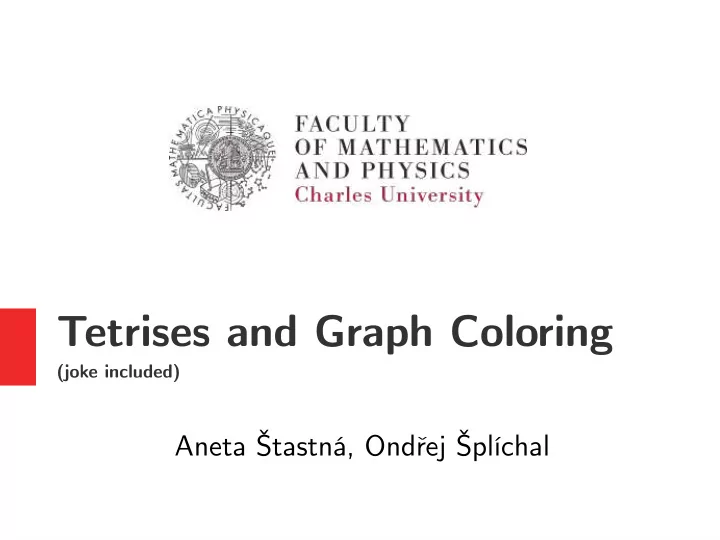

Tetrises and Graph Coloring (joke included) Aneta Štastná, Ondřej Šplíchal
Erdős–Faber–Lovász conjecture - clique version ● If n complete graphs, each having exactly n vertices, have the property that every pair of complete graphs has at most one shared vertex, then the union of the graphs can be colored with n colors. ● Example: n = 5
Tetrises New Perspective on EFL
Difgerent perspectives on EFL
Tetris with maximal number of crossings T ● Each two cliques intersect in one vertex. ● No vertex belongs to more than 2 cliques.
Coloring of T
Coloring of T
Coloring of T
Coloring of T
Coloring of T
Coloring of T
Coloring of T
Coloring of T
Coloring of T
Coloring of T
Coloring of T
Coloring of T
Coloring of T
Coloring of T
Coloring of T
Coloring of T
Coloring of T
Coloring of T
Coloring of T
Coloring of T
Coloring of T
Coloring of T
Coloring of T
Coloring of T
Coloring of T
Coloring of T
EFL and b-coloring of tight bipartite graphs ● [Lin, Chang (2013)]: EFL implies that class Bn of tight bipartite graphs is n- or (n-1)-b -colorable. ● In proof EFL is used as following: Let G be tight bipartite graph and G* it’s conversion to graph satisfying hypothesis of clique version of EFL. If G* is n colorable, then G is n - or (n-1)-b -colorable.
EFL and b-coloring of tight bipartite graphs ● S(Kn) – graph created from Kn by subdivision of all edges ● Tetris for S(Kn)* is maximal tetris.
EFL and b-coloring of tight bipartite graphs ● n -b-colorability in tetrises: all bricks with one fjlled tile have distinct colors ● [Lin, Chang (2013)]: – S(Kn) is n -b-colorable for n odd – S(Kn) is (n-1) -b-colorable for n even ● Proof in tetrises: – n odd: from coloring of maximal tetris – n even: S(Kn) not n- b-colorable and EFL holds for S(Kn) from tetris coloring algorithm
EFL and b-coloring of tight bipartite graphs ● Gn,k – taking S(Kn), merging vertices {1,2}, … , {1, k } into one, adding some vertices of degree 1 ● In tetrises: Gn,k* is tetris with one brick with k fjlled tiles, rest are all bricks with two fjlled tiles which can be added (and some bricks with one fjlled tile).
EFL and b-coloring of tight bipartite graphs ● [Lin, Chang (2013)]: All graphs in Gn,k are n- or (n-1) - b-colorable. ● Proof using tetrises: – Color tetris of Gn,k* with n colors (alteration of algorithm for tetris with maximal number of crossings) – Implies n- or (n-1) -b-colorability by theorem of [Lin, Chang (2013)]
EFL and dense graphs ● deg(x) – number of cliques in which vertex/brick x belongs ● Two bricks/vertices collide, if they belong to same clique ● [Sánchez-Arroyo (2008)]: Let k be number of bricks with degree at least deg(x) coliding with x, then
EFL and dense graphs ● New result: – Choose any p bricks. – Denote z number of cliques containing at least one of these chosen bricks. – Let x be any brick with deg(x) > p+1 – Let k be number of bricks with degree at least deg(x) coliding with x – Then – Note that for p = 0 we get result from [Sánchez- Arroyo (2008)]
EFL and dense graphs ● Let d be minimal degree of brick in tetris T and D maximal degree of a brick in tetris T. ● Corollary: – If d > p+1 and – Then T can be colored by at most n colors. ● Corollary (weaker): – If d is at least 3 and d times D is at least 2n, then T can be colored by at most n colors.
Conclusion ● We have seen and understood many difgerent approaches to EFL and it’s connection to other mathematical structures. ● We have proven results about b-coloring of tight bipartite graphs in a difgerent and easier way. ● We have generalized and improved results for dense graphs.
References ● Wu-Hsiung Lin and Gerard J. Chang. b-coloring of tight bipartite graphs and the Erdős–Faber–Lovász conjecture. Discrete Applied Mathematics, 161(7):1060 – 1066, 2013. ISSN 0166-218X. ● Abdón Sánchez-Arroyo. The Erdős–Faber–Lovász conjecture for dense hypergraphs. Discrete Mathematics, 308(5): 991 – 992, 2008. ISSN 0012- 365X. Selected Papers from 20th British Combinatorial Conference.
Joke Thanks for watching!
Recommend
More recommend